It’s difficult to capture in words the painstaking nuance and utter improbability that is really hard, really technical rock climbing such as what is going down on the Dawn Wall this week. Yet it’s worth trying because it’s in those details that climbing is elevated from athletic to aesthetic.
This week on El Cap, two of the best climbers in the world are peaking physically and giving their sport’s greatest venue the performances of their lives. For that reason I think that all the media attention is deserved. Fortunately, Brett Lowell and Corey Rich are up there documenting these efforts. I think we’re all stoked to see the footage that comes out of their cameras this week.
On that note, check out my latest piece for National Geographic, an interview with Corey about his process and some captions to go along with some pretty sick photos.
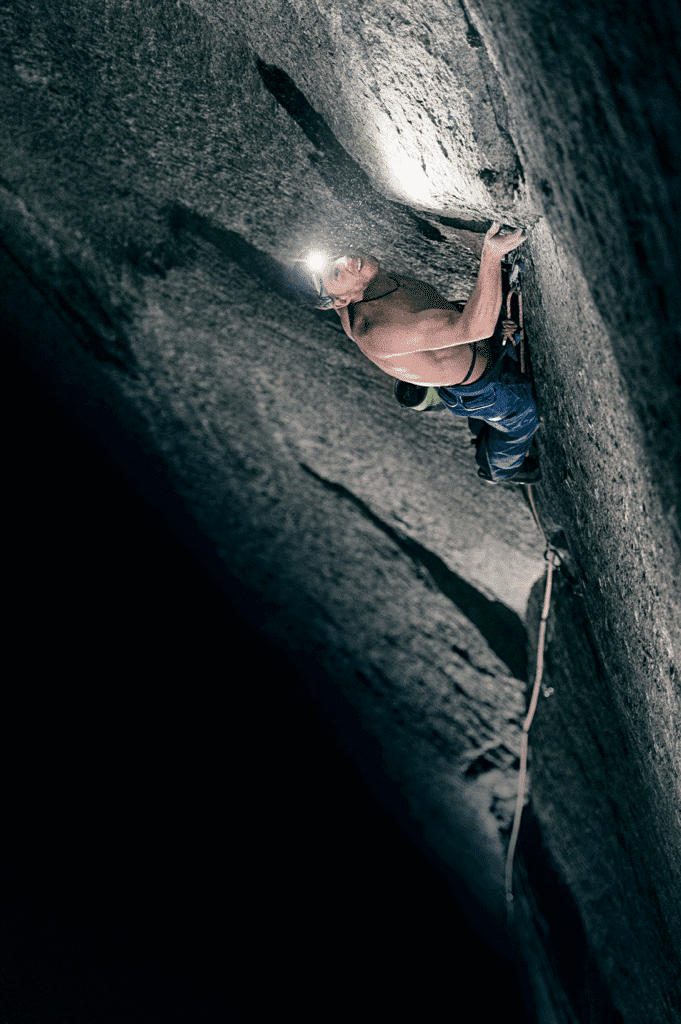
Tommy Caldwell sent the last 5.14 pitch of the Dawn Wall, pitch 17, last night. Photo Corey Rich
1/7 Update
Progress on the Dawn Wall continues. Last night (1/6) Tommy Caldwell redpointed the “second half” of pitch 16—a long stretch of 5.14a liebacking in a corner just above the dyno. This means that Caldwell has now sent all the 5.14s on the Dawn Wall.
“There’s this big learning curve every year, where you have to re-learn the language of the rock,” explained Tommy, speaking to me on his cell phone during an interview on January 5. “But I feel totally dialed in and fluent to that language right now. Like, my brain is just in sync in with the rock.”
Kevin, meanwhile, has a hole in his finger in one of the worst possible places: far forward on the tip. I know from experience that this is one of the most difficult spots to tape well. By all accounts, he’s as close to sending pitch 15 as you can get.
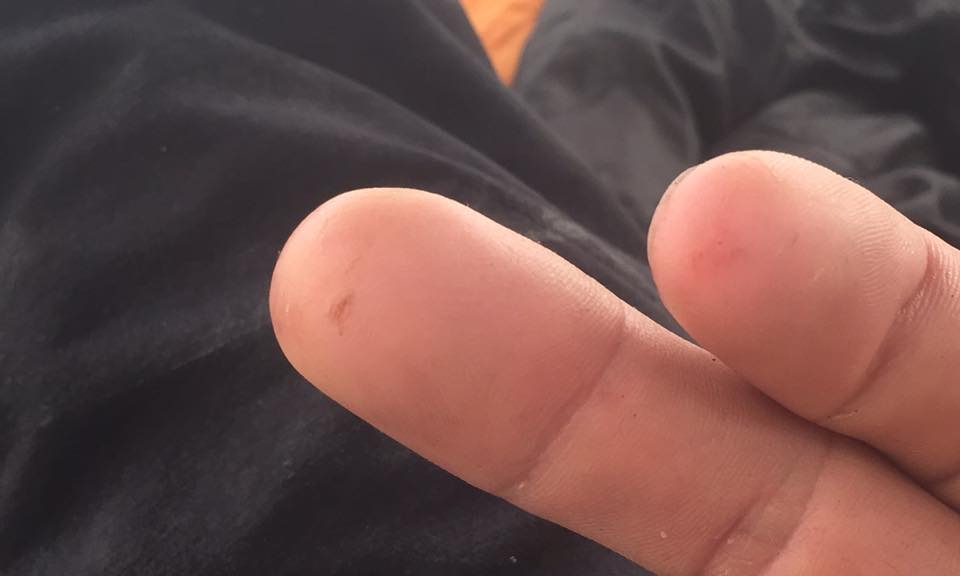
Kevin’s fingers
“The hold he’s falling on is one of the smallest, sharpest holds on the route,” said Tommy. “You can only grab it with two fingers, and both those fingers on Kevin are taped up. It’s makes it a lot harder.”
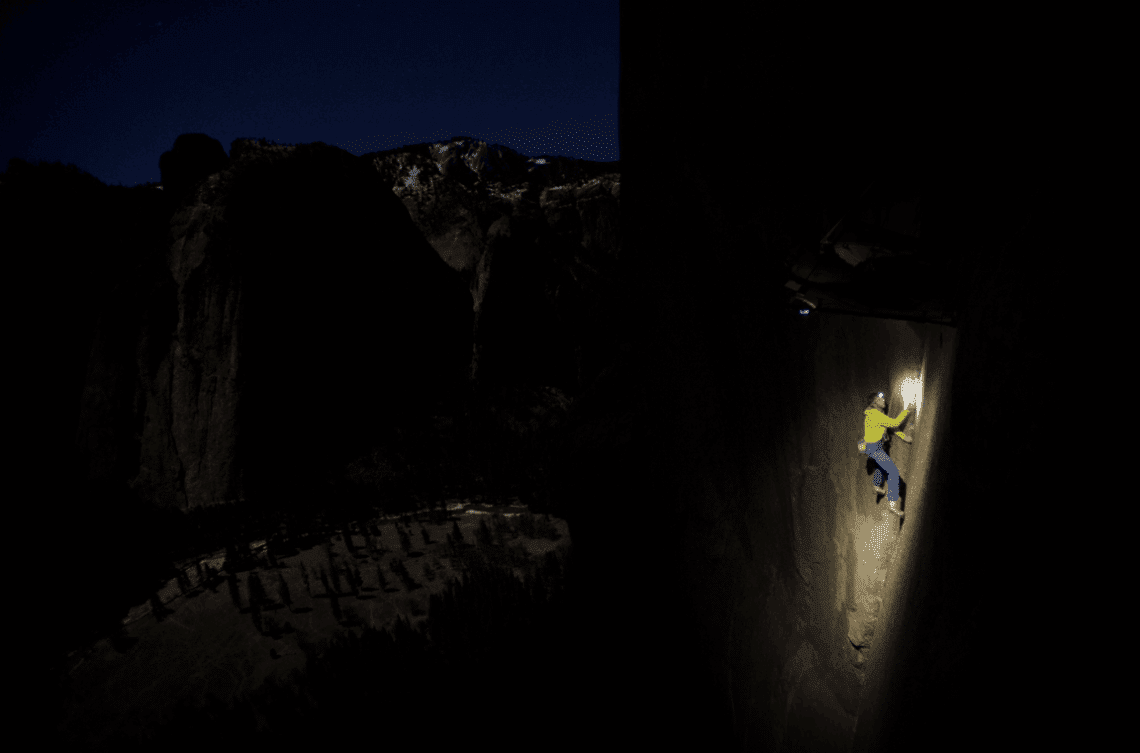
Tommy down climbing pitch 16 in the dark three nights ago to circumnavigate the Dyno. Almost 200 feet of climbing to skip one move! Photo: Corey Rich
Explaining Pitch 16: How Tommy got around the Dyno
Pitch 16 is now two pitches. The “Loop Pitch” (a 5.13+/14a) down climb. And a 5.14a corner above it (pitch 17).
The Loop Pitch is Tommy’s crafty solution to avoiding the Dyno—the 8-foot sideways leap that came to be emblematic of the Dawn Wall’s difficulty thanks to various films over the years. Now Tommy reverses 20 feet of pitch 15, down climbs 80 feet, traverses over to a corner and then climbs back up the corner to reach a no-hands stand just above the Dyno. The climbing on the Loop Pitch is 90 percent on top-rope. And at 5.14a, it’s probably the hardest down climb on El Cap.
From that no-hands rest/belay, there’s either pitch 17, or the remainder of pitch 16—depending on how you look at it. Pitch 17 climbs a sustained 5.14a lieback corner. And it’s the last pitch of 5.14 on the Dawn Wall.
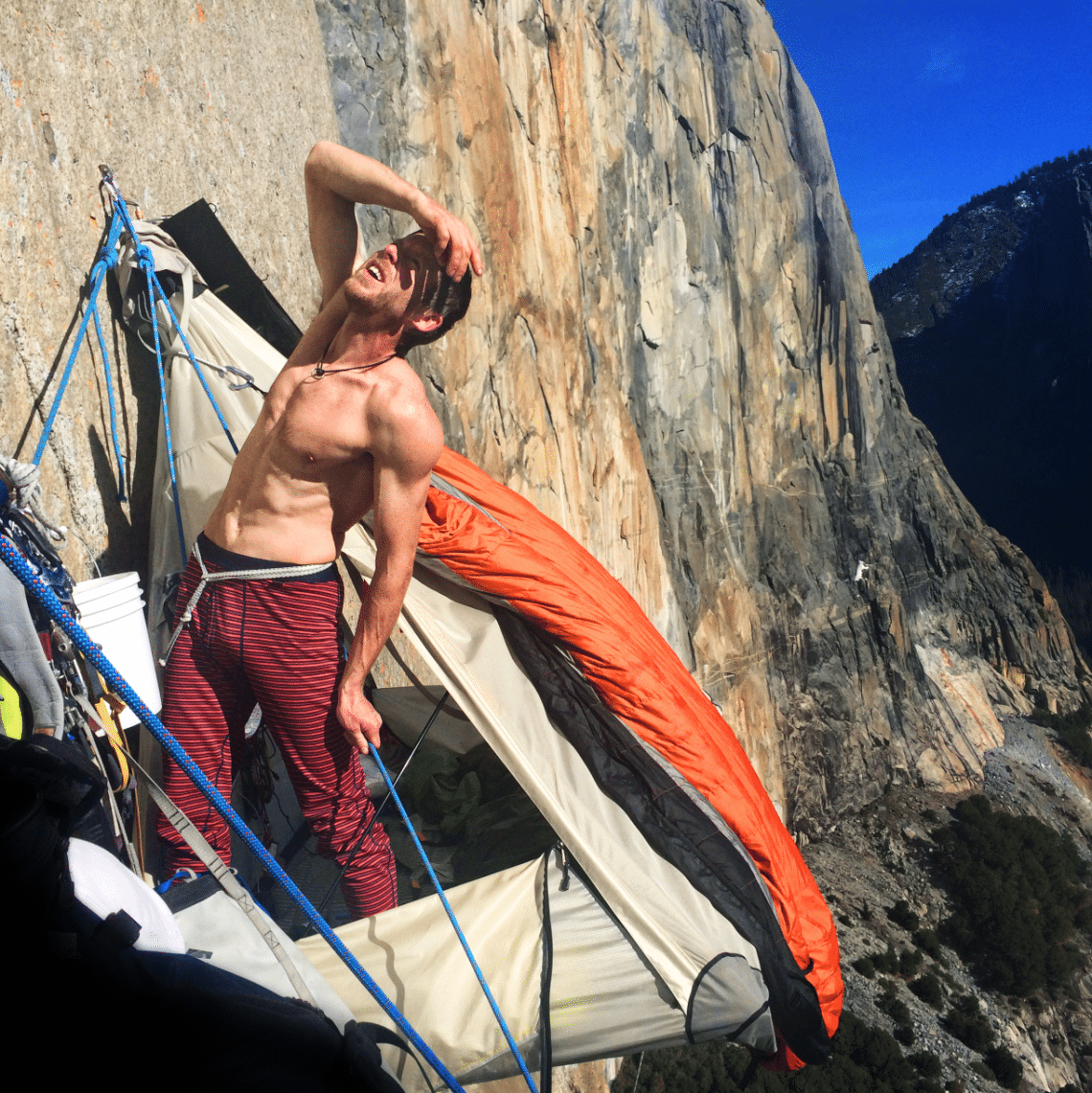
Dawn of a new day. Photo by Corey Rich
The 7 5.14s of the Dawn Wall
On this push, Tommy has climbed a total of 7 pitches of 5.14. By grade, those are:
5.14a (p7)
5.14a (p10)
5.14b (p12, the Molar Traverse)
5.14d (p14, the first crux traverse)
5.14d (p15, the second crux traverse)
5.14a (p16, the Loop Pitch)
5.14a (p17)
What’s Left for Tommy
There are three more pitches of hard 5.13 climbing left before the terrain eases off. Pitches 18-20 go at 5.13c, 5.13c, 5.13d. All three pitches are really long—about 180 feet. Tommy is not treating any of the pitches lightly, despite the fact that they are relatively easier than what he’s already climbed.
“I’m feeling really fit and my body is holding up really well. I’ve been doing wall yoga and push-ups and that’s helped keep my body feeling normal after 11 days on the wall. Eating better food this time has also helped. My skin is thin; that’s the main concern. But all the training I’ve done this year is coming through for me right now.”
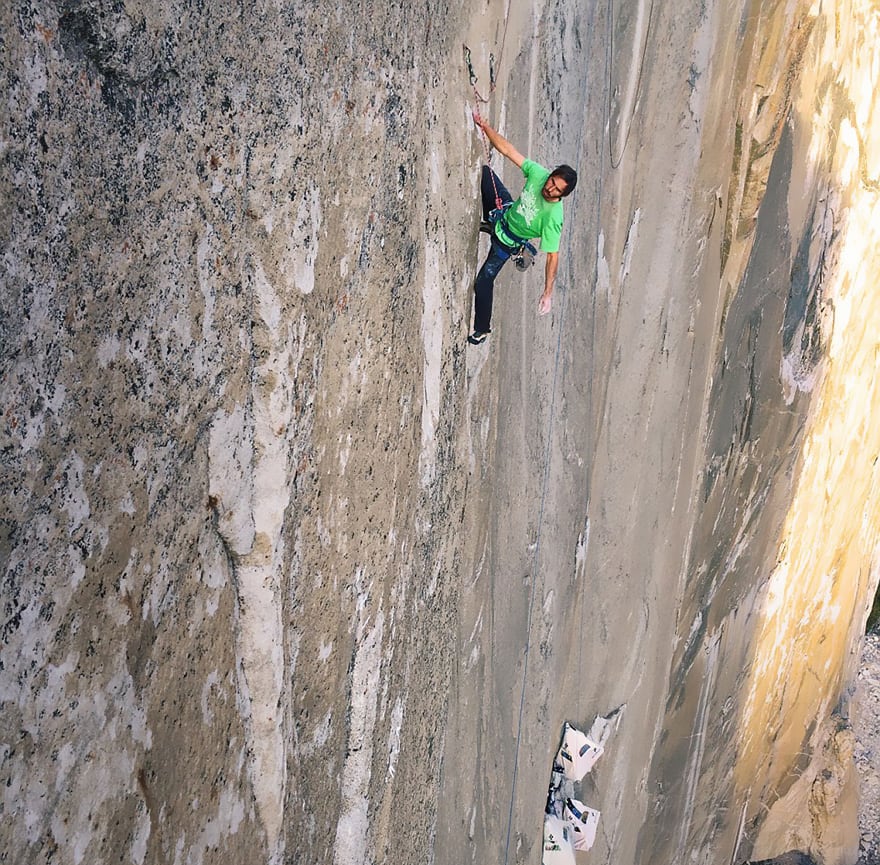
Kevin on pitch 15. Photo Corey Rich
Kevin’s Plan for Pitch 16
Kevin’s goal is to try to climb pitch 16 via the Dyno, through to the no-hands stance, and continue climbing the 5.14a lieback corner (Tommy’s pitch 17). However, he admits that it takes a little pressure off knowing that he can always break pitch 16 up into two pitches as well: The Dyno to the no-hands. Then from there up the 5.14a lieback corner.
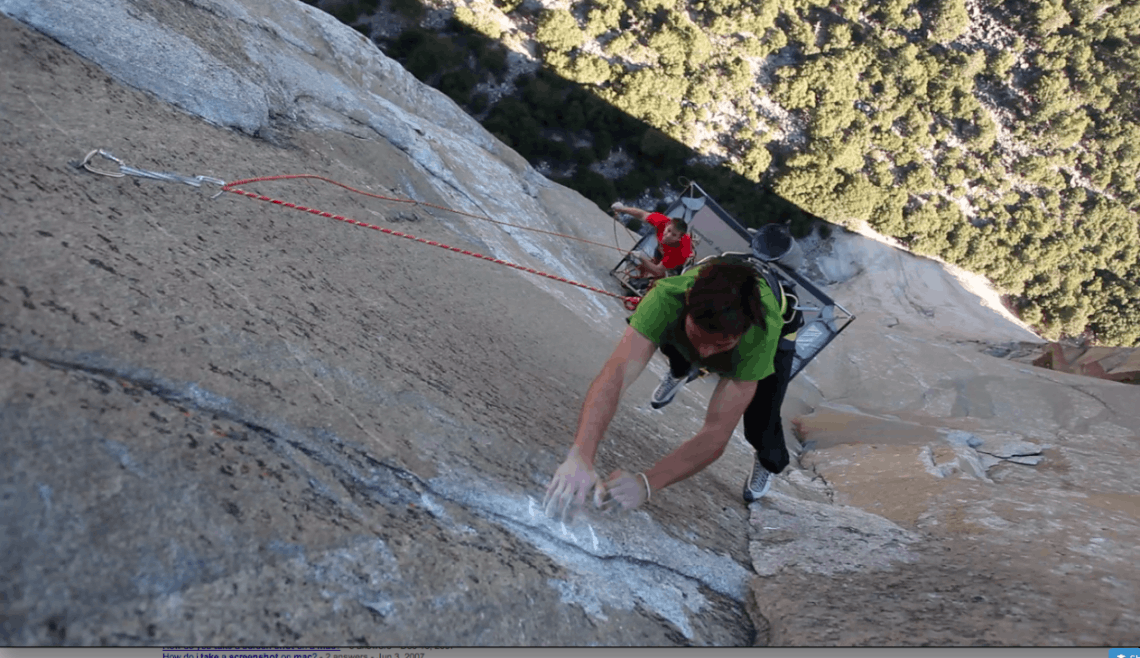
Kevin on the Dyno from an earlier season
“I’ve stuck the Dyno several times,” Kevin said to me on Monday. “I’ve even linked it once, climbing from up from the portaledge. I’m not too worried about the Dyno. It’ll taken little while to remember it. I know it’ll come together. I’ve also linked from the no-hands above the Dyno to the top. My intention is to do it all in one because it would be super rad. Then, if I have to adapt, we’ll see how it goes. We’re climbing no-hands to no-hands everywhere else on the wall, so it’s pretty logical if it has to go the other way, too.”

Photo Corey Rich
Not bad for Kevin’s first El Cap route
Thus far, Kevin has sent 4 of the 7 5.14s. Two of those 5.14s were his first time redpointing: the Molar Traverse (5.14b) and pitch 14 (5.14d).
Kevin: “Clipping the chains on pitch 14 was definitely a high point. I’d never done that pitch. I fell off the last move about a month ago. I knew it was possible, but that’s still different from having actually done it.
“That’s how all the crux pitches are. I haven’t redpointed any of them [till now]. Doing pitch 12 was memorable. That shut me down on our first push. And it felt like a totally different pitch this year—not even in the same ballpark.
“When I get to the top I’m going to drop my harness and never put it back on again. [Laughs]. I’m not literally going to do that, by the way.”

Kevin’s fingers on the crux holds of pitch 15. Screen grab by SparkShot Climbing
The Pitch 15 campaign
A redpoint of pitch 15 has, thus far, eluded Kevin. The battle, in his words:
“You have to climb a long section of 5.13c just to get to the crux of pitch 15. So you have to endure a lot of crimping. Basically what will happen is that my tape wraps separate from each other. At the crux, the strip will peal away and cause a little rolling.
“The move is that you take that crimp and picture manteling it in order to move left. You’re not just pulling straight down on that edge because you have to do an iron cross. There’s so little friction on that hold that I can’t move as statically as I need to. And the left hand I’m moving towards is really bad. You have to hold this position while you shuffle your feet and get your left heel on. It’s a long time to spend on those little razors.
“It’s definitely a pain tolerance and friction type of crux. The moves are hard but the issues is, you have to want to grab. And you have to not give a fuck about how much it hurts. Which is kinda hard to do.”

Tommy’s fingers. Strong looking nub there, TC! Photo: Corey Rich
The Media Frenzy
No other climb has been as well documented as the Dawn Wall. The New York Times has a reporter in Yosemite covering this ascent. Major television networks have covered the ongoing process, to the forehead-slapping chagrin of the core climbing community.
For Kevin and Tommy, there has been a level of balance and discipline between trying to focus on the grand adventure and experience as it unfolds, as well as broadcast the news via social media as it happens.
Tommy: “I almost feel obligated at this point to continue posting. It’s been a tough balance. I’m not doing a ton of interviews. It was something I was really uncomfortable with at first. But I feel such overwhelming support from the climbing world. I’ve gotten such great feedback that I feel obligated at this point to continue posting to Instagram and Facebook. It’s become such an integral part of this climb.”
Free Climbing, Not Free Soloing
Of course, the general public has continued to make the understandable error of conflating free soloing and free climbing into one interchangeable term to describe what a bunch of thrill-seeking yahoos with a death wish do on the rocks instead of go to the mall and buy more shit they don’t need like most people in America.
And yet … From my perspective great advances have been made in terms of educating the general populace about the nuances of climbing. I think it’s worth being thankful for the fact actual roped rock climbing—something akin to what all of us go out and do every day, albeit on our own vastly more mediocre levels—is generating headlines. And not free soloing this time. That’s great for the sport climbing in general.




So what happens if Kevin isn’t able to do P15 (and the rest of them) clean? Is the entire send “invalidated,” since Tommy hasn’t led every pitch clean? Or is it a little asterisk somewhere, since Tommy will have climbed (led or TRed) every pitch?
Thus far, Tommy has sent every pitch clean. Kevin hasn’t completed pitches 15 and 16. I am sure that what they do will be a topic of discussion for the climbers on the wall today.
I think you’re confused about the top roping aspect of pitch 16. As it’s a down climbing pitch, there is no way to “lead” it …
But Tommy hasn’t lead every pitch through 17 has he? I was under the impression that if Kevin sent first, Tommy would follow on TR (as I think they did when swapping leads on Days 1 and 2). Like b.giuliani, I’m wondering what this would do for the entire send if Tommy finishes (having sent some earlier pitches only on TR) but Kevin doesn’t get past P15. Hopefully those fingers heal up and it’s a non-issue!
You’re correct, Tommy hasn’t led every pitch through 17 … I was just discussing with fellow journalist Dougald MacDonald what to call this …
I think it’s confusing, for sure, what to call it that’s happening up there right now due to the fact that Kevin may not actually send pitch 15 (though who knows). For the record, I just heard that Kevin is taking a break from pitch 15 today, but plans to return to it tomorrow. He gave it four burns last night, and was super close …
Anyway, … there aren’t labels out there that accurately capture this aspect.
Their goal is a “team free” ascent where each climber redpoints each pitch, on lead, or following cleanly as a second. That has gone out the window over the past few days as the team has run into the crux pitches.
First of all, both climbers can only lead pitch 14, and 15. As they are traversing pitches, following would be a nightmare. So they were always both planning on leading those.
In terms of answering your question about what will happen if Tommy continues to free the remainder of the route, but Kevin doesn’t do pitch 15, then I think it would be safe to say, above all, that Tommy Caldwell completed the first free ascent of the Dawn Wall. Hopefully both climbers send every pitch, and we can say Tommy Caldwell and Kevin Jorgeson have completed the first free ascent of the Dawn Wall in a team-free style.
Either way, what they’re doing is unprecedented in so many ways, so of course there aren’t any neat labels that succinctly describe what is happening. But you can be sure that both TC and Kevin have the highest standards for themselves and for climbing style possible, so whatever they call it is fine with me
That all makes sense. I agree completely and was just curious as to your thoughts on this aspect. Thanks for all the awesome write-ups and updates!
I thought that a “team free” ascent meant that at least one of the team freed every pitch but no individual freed it all (leading or following – Kevins fingers would like that!). I’d say this is more like a classic free ascent where one leads, the pitch gets seconded free, then they swap leads as it would be really contrived to have both members of the team lead every pitch. Not that words matter much in this case but from what I have read they think that to call it a free route at least one of them has to climb all the pitches free even if some of those were followed free. Which I think would (should) be considered a free ascent of the route.
The next burly step is to lead it all. Then in a day, etc.
Pretty amazing amount of prep and work for this route. So cool to see people willing to put everything they have into completing a dream and leave no excuses.
All pitches have been led thus far. In some cases both climbers have led the pitches, and some cases they have led, and followed, free.
The only pitch that wasn’t a very traditional lead, was the first half of pitch 16, which is a down climb from the belay. You’re “leading” only you’re down climbing, which kinda looks like top-roping in reverse 🙂
Oh yeah I realize that all pitches have been led – I believe that their goal is for each of them to have free climbed the entire route either leading or following – what I would call “classic style”. I thought that a team free ascent referred to just calling it good if someone leads a pitch and then the second follows on Jumars therefore climbing only half of the route free.
So if Tommy is leading pitch 17 while Kevin is temporarily “stuck” trying to finish pitch 15, who is belaying Tommy at that point? And who is belaying Kevin while he continues to try to lead pitch 15? I’m not questioning the legitimacy of the methods or even wondering what to call it… I’m just trying to understand what Tommy and Kevin are doing up there. Are they using self-belay techniques, or is one member of the team jugging up and down so that the pair can continue to belay each other even as they separate and work of different pitches?
Andrew, can you explain what Tommy is doing while waiting on Kevin to complete pitches 15 & 16? How does he belay? Does he lower himself to join Kevin? And if so, does he re-climb those pitches on aid?
Thanks,
Charlie
IG: @lazerguidedmelodies
Currently, Tommy has completed through pitch 20 (21). Now he is going to head down and belay Kevin on pitch 15 tomorrow night.
Both climbers have been belaying each other the whole time. They move up and down the wall thanks to a well-rigged web of fixed ropes. This is expedition style climbing on a big wall. They have an advanced camp set up right in the center of the six hardest pitches, where they have spent the past 8 or 9 days. Once Kevin catches up with Tommy, then the two are going to climb the last 12 pitches in traditional wall style, swinging leads and climbing upward and hauling their gear
Thanks for the awesome coverage.
Question – Are Kevin and Tommy following Warren Harding’s aid line very closely, or is this more of a completely new route?
I’ve looked on Google and I can’t find the name of original aid route. I’m just curious because this is always reported as trying to “free the Dawn Wall,” and not “trying to free ________ (insert Harding’s route name here).” Thanks.
Hey Andrew, I just read your article on Nat Geo’s site. I heard Kevin mention the “Aussie Tape” as well – any idea how to get that stuff in the US and have you ever tried it? I’ve just been using Metolius which gets destroyed on New York and New England schist
No, I haven’t had a chance to look into it. But I’m interested as well. I’ll see what I can find and let you know!
Thanks man!